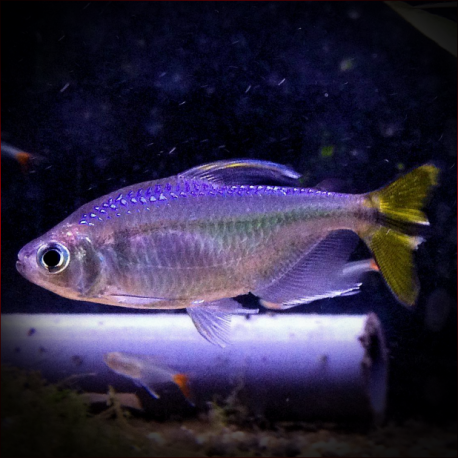Alestopetersius Caudalis
Characiformes Print
More info
Datasheet
| Minimum Tank Size | 160 litres / 42.27 US gallons |
| Maximum Size | 6.0cm / 2.36inches |
| Temperature | 22°C / 71.60°F - 26°C / 78.80°F |
| Hardness | 2.02dgH / 36ppm - 15.02dgH / 268ppm |
| pH | 5.0-7.5 |
General Description
The Yellow-Tailed Congo Tetra, scientifically known as Alestopetersius Caudalis, is a vibrant fish characterized by its striking coloration and elongated fins. Adult males display extended, white-tipped dorsal, ventral, anal, and caudal fins, making them more colorful and larger than females. Often referred to by alternate names such as 'yellow-finned' or 'yellowtail' tetra, these fish are part of the Characiformes order and belong to the Alestidae family, known for its diverse members ranging from tiny micropredators to large piscivores.
Aquarium Setup
To house the Yellow-Tailed Congo Tetra adequately, an aquarium with a minimum size of 160 liters is recommended. The tank setup should mimic a flowing stream or river environment, featuring a mix of rocks, sand, fine gravel, water-worn boulders, driftwood roots, and branches. While decor is not crucial, the presence of plants can enhance the overall aesthetic. Water conditions should maintain a temperature between 22-26°C, a pH level of 5.0-7.5, and a hardness ranging from 36-268ppm. For further details on tank setup, refer to the provided table.
Behaviour
These tetras are known for their lively and skittish nature, although they generally exhibit peaceful behavior, making them suitable for community aquariums. Yellow-Tailed Congo Tetras tend to interact playfully, especially during competitive displays among rival males vying for female attention or hierarchy within a group. They thrive in the company of at least 8-10 individuals, typically showcasing their best colors when engaged in social interactions.
Feeding and Diet
In their natural habitat, Yellow-Tailed Congo Tetras are foragers, consuming small insects, crustaceans, and fallen fruits. In aquariums, they readily accept a diet of live and frozen foods like bloodworms, Daphnia, and Artemia, supplemented with high-quality dried flakes and granules. A varied diet that includes plant or algal components is essential to maintain optimal health and vibrant colors.
Reproduction & Dimorphism
Breeding Yellow-Tailed Congo Tetras in captivity is not common due to limited available information. They are egg-scatterers without parental care, with one suggested breeding method involving a group of adults in a separate tank equipped with an artificial trap to collect eggs. Males exhibit more vivid colors and grow larger than females, showcasing extended, white-tipped fins that distinguish them from their female counterparts.
Habitat and Distribution
The Yellow-Tailed Congo Tetra originates from the Lower Congo region in the Democratic Republic of Congo, primarily inhabiting waters around Lake Tumba and its surrounding areas. Found in streams and rivers, their natural habitat aligns with other alestids like Micralestes species, Bathyaethiops caudomaculatus, and Phenacogrammus deheyni. Little is known about their specific habitat preferences or behaviors in the wild due to limited research.

